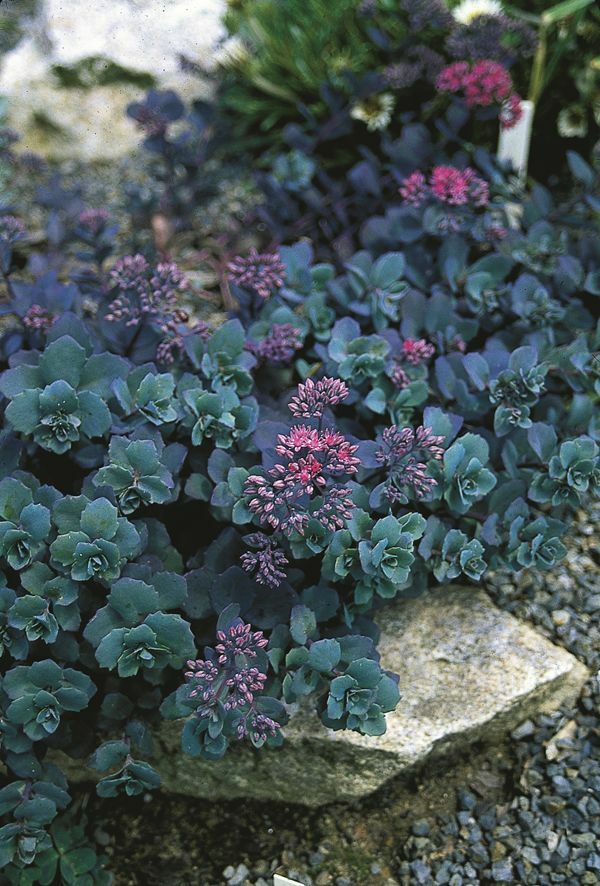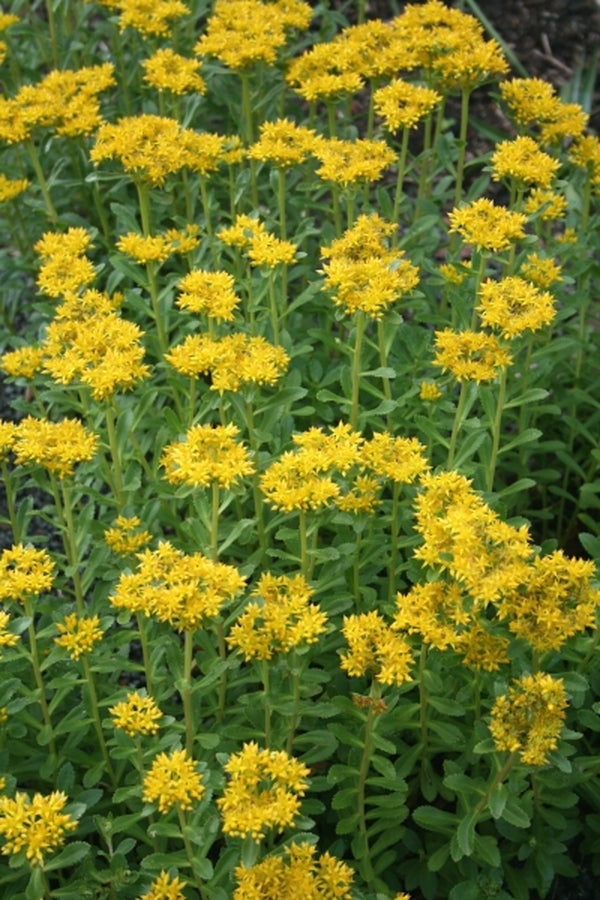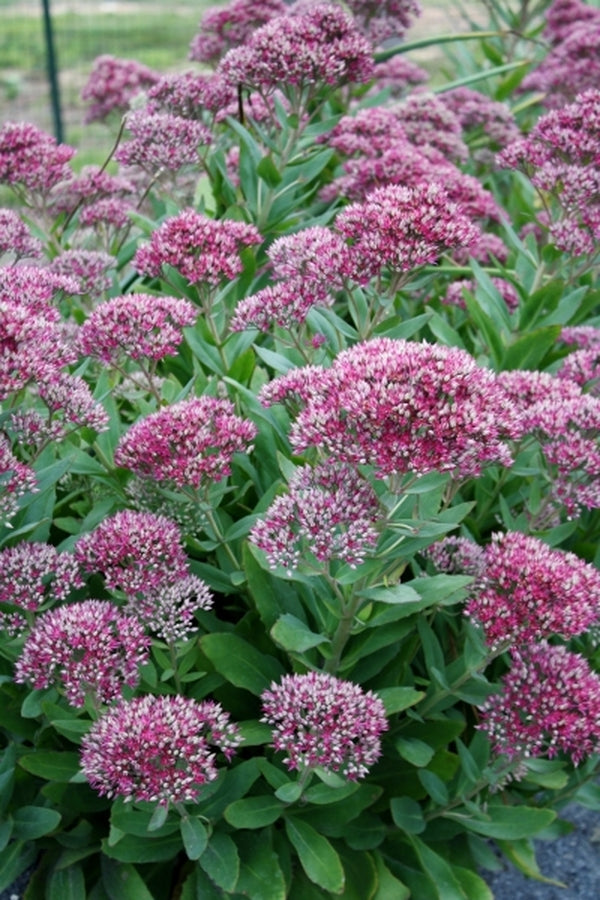Sedum (Stonecrop) is an easy to grow group of succulents that look great in the summer and autumn garden. Here at Plant Delights Nursery, we have been growing sedum plants for over 25 years in our hot, humid, rainy Raleigh garden and so we thought we'd pass on our expert tips for growing sedum plants as well as the names of our favorite varieties of these popular succulent plants. The genus Sedum is a diverse group that includes upright tall sedums, mat-forming carpet sedums, insanely drought tolerant sedums and sedums that need to drink regularly, sun loving sedums and woodland garden sedums. So it is important to know your sedum before you plant. Some taxonomists have moved the tall sedums into the genus Hylotelephium, but tall or short, we still call 'em sedum.
A Sedum Primer - Tall versus Creeping
Tall Sedum
For the garden, there are two main groups of sedums, tall sedums and creeping sedums. The tall sedums (mainly Sedum spectabile, Sedum telephium) have upright stems that grow from 1 to 3 feet tall depending on variety and conditions. New cultivars of tall sedums have been bred to be shorter which means they are less floppy and in better proportion to today's smaller gardens. The stems of tall sedum are clothed in fleshy succulent leaves along their length and are topped in summer or autumn with colorful flower clusters. Tall sedums have been traditionally grown for their symmetrical form and colorful flowers, but newer varieties of tall sedum also feature colorful leaves in shades of copper, dusky mauve and dark purple.
Sedum telephium 'Sunset Cloud'
Creeping Sedum
The creeping sedums (like Sedum ternatum, Sedum tetractinum and many others) are a wildly variable group with long narrow stems that grow along the ground and form mats of colorful fleshy foliage. Traditionally, creeping sedums are grown for their colorful foliage (blue, yellow, copper, marron and more!) or for their draping form which softens the edge of containers and the rock walls that they have been tucked into. Although not specifically grown for flowers, creeping sedums do produce attractive but short sprays of flowers.
There are also a few stonecrop plants that are intermediate between tall and creeping sedums (e.g., Sedum ussuriense) but these are fairly rare and available from time to time only at specialty plant nurseries like Plant Delights Nursery.
How Often Should You Water Stonecrop?
Tall sedums like Autumn Joy, Frosted Fire, and Dynomite (some of our favorites) are fairly drought tolerant but you will get the largest, most floriferous plants with regular (weekly) water while the plant is actively growing (spring to fall). In very dry conditions, the tall sedums will grow much more slowly, not fill out and branch as much, and may even get spindly.
Sedum tetractinum
The best stonecrops for super dry conditions are certain creeping sedums (e.g., Sedum tetractinum, S. scre, S. album, S. kamshaticum and many others). Be careful when selecting a creeping sedum for a dry site because some creeping sedums (e.g., Sedum ternatum) do not tolerate drought. Once the active growing season is over, you should greatly reduce watering to prevent winter rot. If you are not sure whether it is time to water a stonecrop, err on the dry side...when it doubt, give it drought.
What type of Soil is Best for Sedum?
No matter what type of stonecrop plant you buy you should plant it in well drained soil. Heavy wet soil is sure to rot both tall and creeping sedums alike. Their fondness for well-drained soil makes sedum plants great for raised beds, hillside slopes, sandy soil, rock gardens, crevice gardens, containers, and green roofs.
How Much Sun Should Sedums Receive?
Most sedums like full or part sun (5 or more hours of direct sun per day). A few stonecrop species such as Sedum ternatum are woodland plants that like to grow on top of rocks in dappled shade. And some of the highly variegated sedums (like S. alboroseum 'Lemonade') with pale green, yellow and white foliage need dappled sunlight to prevent sunburn.
Sedum tatarinowii 'Thundercloud' PP 21,833
Does Sedum Require Fertilizer?
Sedums generally prefer lean conditions so go easy on the fertilizer. An organic compost applied is best. Chemical fertilizer can lead to stretching and flopping.
How to Prune Stonecrop Sedum:
Creeping sedums generally do not need to be pruned unless they grow out of bounds. Tall sedums can be tip pruned in spring to control the height but this will delay the onset of flowering. Tall sedums die back to a ground-level rosette in the winter. Many gardeners prefer to leave the dried stems and flowers of tall sedums in place during autumn and early winter as even dead, they are attractive when frost coats them. However once they have been smashed down by snow or ice, they can be pruned or pulled.
Sedum ternatum 'Eclair'
Sedum in Containers:
Both tall and creeping sedums are excellent container plants provided that you use a decent potting mix that both retains water and drains it. Tall sedums look great in a patio container and creeping sedums are excellent spiller companions to tall container plants such as cactus and agave. Creeping sedums also look great tucked into the nooks and crannies of strawberry pots, pallet gardens, rock walls and wall gardens. And creeping sedums are perfect for hanging baskets too as their long stems drape down over the edge of the pot.
Sedum Ground Covers:
Tall sedums do not spread but when grown in mass plantings are beautiful and tough ground covers. Perfect for filling a hillside or fleshing out the middle of a perennial border. Creeping sedums will spread slowly but surely and make a very low ground cover for sunny spots. Perfect for containers, along the edge of walls, sidewalks, and for draping over rocks.
Sedum bithynicum
Using Sedum for Wall Gardens and Roof Gardens:
The low water requirements and spreading nature of creeping sedums make them perfect plants for wall gardens, crevice gardens and roof top gardens. Stonecrop is the go-to plant for roof gardens on industrial buildings like the 10.4 acre Ford truck plant in Dearborn Michigan or the 32000 sq ft. Toronto City Hall. And in Europe, there are literally millions of square feet of green roofs covered mostly with stonecrop plants. Most of these gardens are not irrigated and the sedum thrives only on rainfall.
Autumn Sedum and Winter Sedum:
Tall sedum cultivars like Autumn Joy are renowned for their wonderful fall flower show. When much of the garden is winding down, the autumn sedums are peaking. As fall morphs into winter tall sedums dry up and are still attractive with their frost-kissed stalks. The creeping sedums can also shine in winter as some, like Sedum tetractinum have leaves that turn red or purple in the winter.
Sedum aizoon var. angustifolium coll. #HH-03CH165
Sedums and Cut Flowers:
Tall sedums produce excellent cut flowers. Once most of the florets are open, cut the stem, strip some of the leaves at the bottom and enjoy. Tall sedum cut flowers also dry well.
How to Propagate Sedum:
Creeping sedums are ridiculously easy to propagate. Pull up or cut some of the stems and lay them on top of some potting soil or stick them shallowly into the potting soil. Large clumps of tall sedums can be propagated via division or via stem cuttings too. Sedum stem cuttings should be 3 to 5 inches long and the leaves should be stripped from the bottom inch or so before being stuck.
Sedum 'Class Act' PP 20,125
Our Favorite Sedum Varieties:
As for the tall sedums:
Sedum 'Black in Black' (Back in Black Stonecrop) is an upright, purple-leafed stonecrop that forms a tight deciduous clump and reaches 1.5' tall by 1.5' wide.
Sedum 'Dynomite' (Dynamite Stonecrop) has excellent flower color and purple leaves which makes it a favorite.
Sedum 'Frosted Fire' (Frosted Fire Stonecrop) has russet flowers and variegated foliage.
As for creeping sedums:
Sedum bithynicum (Turkish Stonecrop) forms wonderful blue foliage.
Sedum 'Boogie Woogie' (Boogie Woogie Stonecrop) is a recently introduced groundcover with beautiful variegated foliage.
Sedum tetractinum has nice green leaves that turn reddish in the winter.
Sedum spurium has smaller leaves and is quite cute.
Sedum mexicanum 'Lemon Ball' is a really tiney, yellow-leaved sedum cultivar.
So when you want to buy succulent plants online you should definitely consider trying some of our sedum for sale. You'll be happy that you did. And when you are looking where to buy succulents, please consider Plant Delights Nursery. We'll be happy that you did...and so will you.

